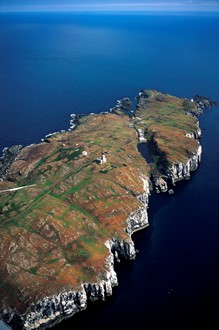21 February, 2018
Scottish Natural Heritage reduces carbon emissions by 20 per cent over past two years
Following 2009 climate change legislation by the Scottish Government that requires public bodies to contribute to the delivery of national targets including reducing carbon emissions by 80 per cent by 2050, Scottish Natural Heritage (SNH) put into place measures to ensure we would not only meet, but exceed this target. SNH has achieved a nearly 20 per cent reduction over the last two years, far surpassing expectations.
We have achieved these reductions though a wide range of initiatives across the organisation, including:
- Evolving Smarter Working so we make space to share our buildings with other public organisations, reducing our gas and electricity use
- Reducing reliance on paper by rolling out laptops to all our staff
- Reducing business travel by encouraging the use of video-conferencing
- Encouraging the use of public transportation, carpools, walking, or cycling when travel is necessary
- Choosing sustainable goods, services or works that comply with the Government Buying Standards
SNH has also started replacing petrol and diesel cars, expecting to replace its fleet with electric cars by 2026. This is ahead of the Scottish Government’s target to phase out the need for new petrol and diesel cars and vans by 2032.
Mike Cantlay, SNH Chair, said: “Securing the environment for future generations is at the heart of SNH’s activities. One of the most important ways we can do this as an organisation is by reducing our carbon footprint, combatting the effects of climate change. We have changed many of our business practices to help reduce carbon emissions, and it’s been great to see our staff take this mission to heart – for example, by arranging meetings to tie in with train schedules and using suppliers who also prioritise reducing waste.
“In the past year alone, we have reduced our carbon emissions by 78 tonnes. It’s been a fantastic effort, but there’s more to do. The Scottish government has set a target reducing carbon emissions throughout Scotland by 80% by 2050, and as a public sector organisation we take our role in this seriously. We remain committed to making further reductions in the future, as well as advising and supporting other organisations in their own efforts to do the same.”
SNH’s work to reduce its own carbon emissions is part of its larger goal of reducing carbon emissions and improving the environment across Scotland. The organisation plays a lead role in restoring peatlands to reduce emissions nationally, and protecting habitats and species at risk from climate change.
-ENDS-
Media queries - contact Carrie Wieteska on 0131 316 2631 or carrie.wieteska@snh.gov.uk or the Inverness press office on 01463 725022.
Photos - Credit SNH for all pictures. Isle of May photos are of solar panels on the research accommodation facility, and an aerial view of part of the Isle of May. The third picture is of an electric vehicle at Loch Leven National Nature Reserve.
Contact information
- Name
- SNH Media
- snhmedia@snh.gov.uk
Notes to editors
About Scottish Natural Heritage
Scottish Natural Heritage is the government's adviser on all aspects of nature and landscape across Scotland. Our role is to help people understand, value and enjoy Scotland's nature now and in the future. For more information, visit our website at www.nature.scot or follow us on Twitter at http://twitter.com/nature_scot
SNH has made reducing carbon emissions a key part of our business practices. Since 2011, we have reduced our office space by 40%; 17 of our 36 offices and visitor centres are co-working spaces with other organisations. We have encouraged the use of videoconferencing for over ten years and, over the past five years, estimate a savings of £40k in staff time and £40k avoidance in staff travel costs. Our staff are also encouraged to participate in the Scottish Workplace Journey Challenge (Sustrans) and travel to work via foot, bike, public transport, or lift-share; in 2017 SNH staff participation in this challenge saved 2.4 tonnes of carbon.
About The Climate Change Act
The Climate Change (Scotland) Act 209 was passed unanimously by members of the Scottish Parliament on 24 June 2009, with the aim of reducing greenhouse gas emissions and transitioning to a low carbon economy. Amongst other provisions, the Act creates the statutory framework for greenhouse gas emissions reductions in Scotland by setting an interim 42 per cent reduction target for 2020 and an 80 per cent reduction target for 2050.
Further to the Act, in 2015 the Scottish Government introduced The Climate Change (Duties of Public Bodies: Reporting Requirements) (Scotland) Order requiring all Public Bodies who appear on the Major Player list to report annually to Scottish Ministers on their compliance with the climate change duties.
NatureScot is Scotland's nature agency. We work to enhance our natural environment in Scotland and inspire everyone to care more about it. Our priority is a nature-rich future for Scotland and an effective response to the climate emergency. For more information, visit our website at www.nature.scot or follow us on X at https://x.com/NatureScot
’S e NatureScot buidheann nàdair na h-Alba. Bidh sinn a’ neartachadh àrainneachd na h-Alba agus a’ brosnachadh dhaoine gu barrachd suim a chur ann an nàdar. Tha e mar phrìomhachas againn gum bi nàdar na h-Alba beairteach agus gun dèilig sinn gu h-èifeachdach le èiginn na gnàth-shìde. Tha an tuilleadh fiosrachaidh aig www.nature.scot no air X aig https://x.com/NatureScot



